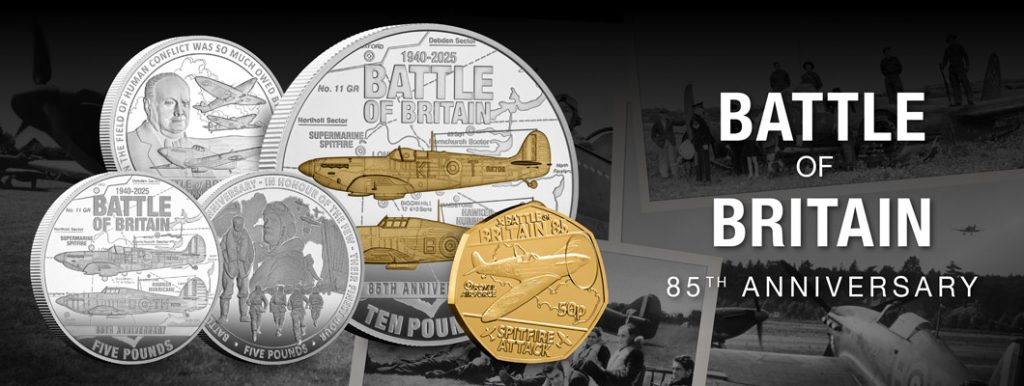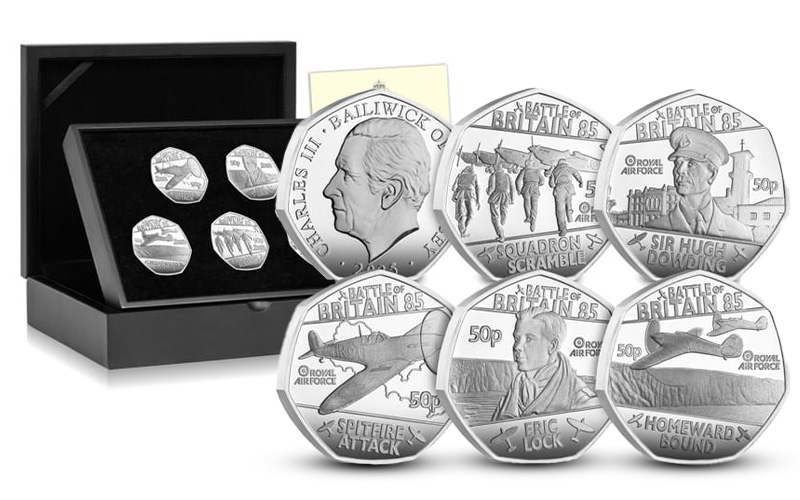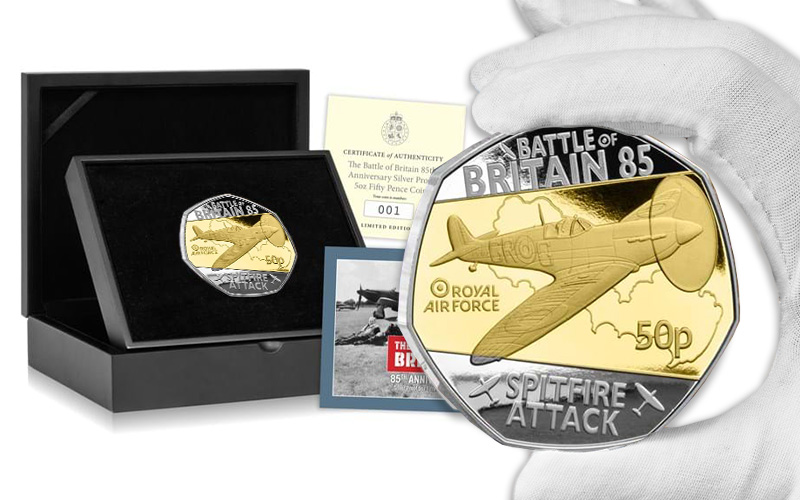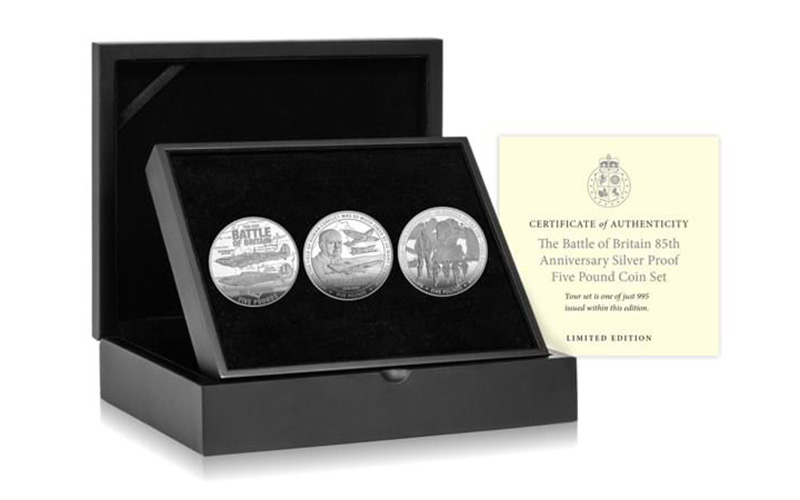British History
Commemorating Courage: The Battle of Britain Coin Range
In the summer of 1940, the skies above Britain became the front line of one of the most defining moments in modern history—the Battle of Britain. As Nazi Germany launched its relentless aerial assault, it was a group of young Royal Air Force pilots, many barely out of their teens, who stood as Britain’s last line of defence.

Against impossible odds, these brave men—later immortalised by Winston Churchill as “The Few”—repelled the Luftwaffe and changed the course of the Second World War. Their courage, determination, and sacrifice remain a source of national pride and international admiration to this day.
85 Years Later: Honouring a Nation’s Finest Hour
This year marks the 85th anniversary of the Battle of Britain. To commemorate this momentous occasion, a new range of limited edition coins has been released, celebrating both the heroism of the RAF and the historical legacy of the battle itself.

More than just currency, these coins are miniature works of art—crafted with exceptional detail, officially licensed by the RAF, and struck to the highest collector standards.
Here are three standout releases in the new commemorative range:
🔷 The Official RAF Battle of Britain 85th Silver 50p Set

Limited to just 450 worldwide, this exclusive set includes five silver 50p coins, each one illustrating a key scene from the battle. From the iconic Spitfires soaring in formation to the resilience of those on the home front, this set offers a complete narrative in precious metal.
👉 Explore the 50p Silver Set
🔷 The Battle of Britain 85th Anniversary Silver 5oz 50p – Special Edition

Crafted from a substantial 5oz of Pure Silver, and finished with selective 24-carat gold plating, this stunning large-format coin is limited to just 200 pieces worldwide. A commanding tribute to one of history’s greatest aerial battles.
👉 See the 5oz Special Edition
🔷 The Battle of Britain Silver Proof £5 Set

Struck in pristine silver proof quality, this set combines timeless coin artistry with a heartfelt tribute to “The Few”. It’s the perfect way to mark this historic anniversary.
👉 Discover the £5 Silver Set
Preserve History in Your Hands
Whether you’re a lifelong collector or simply someone who appreciates British history, the Battle of Britain 85th Anniversary Coin Range is a powerful way to honour the heroes of 1940. These editions are strictly limited and expected to sell out quickly.

The Coins That Nearly Didn’t Exist: The Unique Story Behind the Tutankhamun Treasures 50p Set
In 1922, the world was captivated by the discovery of Tutankhamun’s Tomb – a treasure trove of ancient Egyptian artefacts buried beneath the sands of time.
Over 100 years later, that moment has been honoured with a remarkable set of 50p coins – The Tutankhamun Treasures BU 50p Collection.
Approved by TWO monarchs and featuring THREE distinct dates, these coins carry a story as compelling as the artefacts they commemorate…
Watch our latest video below to discover the story behind the Tutankhamun Treasures BU 50p Set.
Approved by TWO monarchs
Originally approved by Queen Elizabeth II in 2022, the Tutankhamun Treasures 50p Coins were among the very last coins to receive her approval before her sad passing in September 2022.
But the change in monarchy put everything on pause. To proceed, the coins needed to be resubmitted to Buckingham Palace and King Charles III.
And in early 2023, the coins were officially reauthorised for release by King Charles III – now bearing His Majesty’s effigy by Glyn Davies, these were the FIRST 50p coins ever issued with this portrait.
Featuring THREE distinct dates
The unusual journey that these coins took to be released has created a truly rare collecting quirk – each coin features three different years!
- 1922 – Marking the discovery of Tutankhamun’s Tomb
- 2022 – When Queen Elizabeth II first approved the coins
- 2023 – When King Charles III re-authorised the coins for release
Triple-dated coins are exceptionally uncommon in numismatic history. In fact, the most comparable example was the Team GB 50p issued after the delayed 2020 Olympics – and that became one of the most sought-after coins of its year.
Time is running out…
We’re now down to our last remaining stocks of the Tutankhamun Treasures 50p Set, which means it won’t be long until these coins are lost to the sands of time…
Each coin in the collection has been struck to a Brilliant Uncirculated finish and features an ancient artefact that was discovered in Tutankhamun’s Tomb – including his iconic Death Mask, the Anubis Shrine, a Pendant, a Corselet and a model of the young pharaoh’s torso.
Celebrate the 20th Wedding Anniversary of King Charles III and Queen Camilla
On 9th April 2025, we celebrate a significant milestone in the history of the British Royal Family — the 20th Wedding Anniversary of King Charles III and Queen Camilla. Their enduring partnership, which began officially in 2005, has become a cornerstone of the modern monarchy. To honour this landmark occasion, a specially curated collection of commemorative coins and covers has been released, showcasing royal elegance and craftsmanship.

A Royal Wedding with a Twist of History… resulting in an error.
Originally scheduled for 8th April 2005, the royal wedding was unexpectedly postponed due to Prince Charles attending the funeral of Pope John Paul II. The ceremony ultimately took place on 9th April, but by then the Royal Mail had already issued a Miniature Stamp Sheet marked with the original wedding date. This rare philatelic detail is now a part of the anniversary collection — a historical quirk that adds both charm and collector’s value to the commemorative items.
The Design: Elegance and Tribute
At the heart of the collection is a beautiful coin design featuring a dual effigy of Their Majesties King Charles III and Queen Camilla. It is detailed with the original wedding date, the anniversary year, denomination, and the inscription “20th Wedding Anniversary.” This harmonious design captures both their regal stature and the sentiment of the occasion.
Explore the Collectibles
The Brilliant Uncirculated £5 Coin (Product Code: 921J) is a fantastic entry-level piece for collectors. Priced at £15.50 (plus £2.99 p&p), it comes presented in a sleek blue Westminster coin wallet and includes a Certificate of Authenticity.
For those seeking a more premium finish, the Silver Proof £5 Coin is available at £125.00 (plus £3.99 p&p) or via five monthly instalments of £25.00. The Westminster Collection has secured an allocation of 150 coins for UK collectors. Each coin has been struck from sterling silver to an immaculate Proof finish. It is housed in a small black presentation box, accompanied by a certificate of authenticity.
The Gold Proof £5 Coin stands at the pinnacle of this commemorative range. Only 10 coins are available for UK collectors, each struck from 22 Carat Gold to a Proof finish. Housed in a refined black presentation box, it includes a numbered certificate and an informative booklet.
Completing the collection is the 20th Anniversary BU £5 Cover, priced at £29.99 (plus £3.99 p&p). This highly collectible cover features the original Royal Mail Miniature ‘error’ Stamp Sheet dated 8th April 2005 and is officially postmarked by Royal Mail on the actual wedding anniversary — 9th April 2025. Errors like an incorrect anniversary date on a stamp are seldom seen, making this Cover a fascinating and truly special tribute to the royal occasion. Presented in a white card folder, it comes with a certificate of authenticity and is limited to just 495 editions, making it a unique philatelic tribute to this royal celebration.
Secure your piece of royal history today, available exclusively on our website. Whether you’re adding to a collection or gifting a moment of history, these anniversary tributes are a celebration of love, legacy, and the enduring British monarchy.










